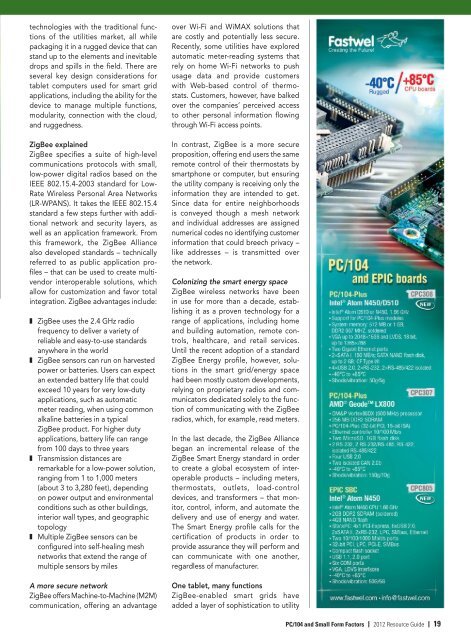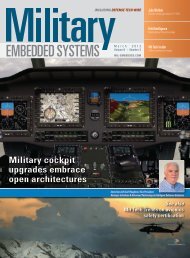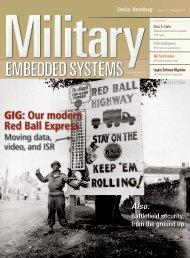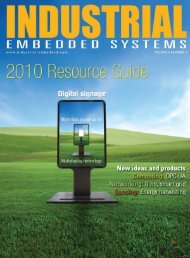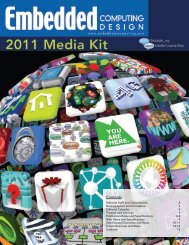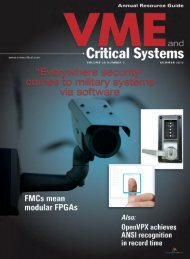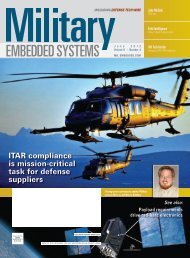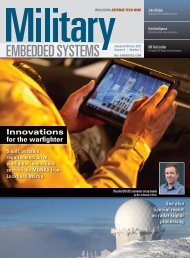Technologic - OpenSystems Media
Technologic - OpenSystems Media
Technologic - OpenSystems Media
Create successful ePaper yourself
Turn your PDF publications into a flip-book with our unique Google optimized e-Paper software.
technologies with the traditional functions<br />
of the utilities market, all while<br />
packaging it in a rugged device that can<br />
stand up to the elements and inevitable<br />
drops and spills in the field. There are<br />
several key design considerations for<br />
tablet computers used for smart grid<br />
applications, including the ability for the<br />
device to manage multiple functions,<br />
modularity, connection with the cloud,<br />
and ruggedness.<br />
ZigBee explained<br />
ZigBee specifies a suite of high-level<br />
communications protocols with small,<br />
low-power digital radios based on the<br />
IEEE 802.15.4-2003 standard for Low-<br />
Rate Wireless Personal Area Networks<br />
(LR-WPANS). It takes the IEEE 802.15.4<br />
standard a few steps further with additional<br />
network and security layers, as<br />
well as an application framework. From<br />
this framework, the ZigBee Alliance<br />
also developed standards – technically<br />
referred to as public application profiles<br />
– that can be used to create multivendor<br />
interoperable solutions, which<br />
allow for customization and favor total<br />
integration. ZigBee advantages include:<br />
ZigBee uses the 2.4 GHz radio<br />
frequency to deliver a variety of<br />
reliable and easy-to-use standards<br />
anywhere in the world<br />
ZigBee sensors can run on harvested<br />
power or batteries. Users can expect<br />
an extended battery life that could<br />
exceed 10 years for very low-duty<br />
applications, such as automatic<br />
meter reading, when using common<br />
alkaline batteries in a typical<br />
ZigBee product. For higher duty<br />
applications, battery life can range<br />
from 100 days to three years<br />
Transmission distances are<br />
remarkable for a low-power solution,<br />
ranging from 1 to 1,000 meters<br />
(about 3 to 3,280 feet), depending<br />
on power output and environmental<br />
conditions such as other buildings,<br />
interior wall types, and geographic<br />
topology<br />
Multiple ZigBee sensors can be<br />
configured into self-healing mesh<br />
networks that extend the range of<br />
multiple sensors by miles<br />
A more secure network<br />
ZigBee offers Machine-to-Machine (M2M)<br />
communication, offering an advantage<br />
over Wi-Fi and WiMAX solutions that<br />
are costly and potentially less secure.<br />
Recently, some utilities have explored<br />
automatic meter-reading systems that<br />
rely on home Wi-Fi networks to push<br />
usage data and provide customers<br />
with Web-based control of thermostats.<br />
Customers, however, have balked<br />
over the companies’ perceived access<br />
to other personal information flowing<br />
through Wi-Fi access points.<br />
In contrast, ZigBee is a more secure<br />
proposition, offering end users the same<br />
remote control of their thermostats by<br />
smartphone or computer, but ensuring<br />
the utility company is receiving only the<br />
information they are intended to get.<br />
Since data for entire neighborhoods<br />
is conveyed though a mesh network<br />
and individual addresses are assigned<br />
numerical codes no identifying customer<br />
information that could breech privacy –<br />
like addresses – is transmitted over<br />
the network.<br />
Colonizing the smart energy space<br />
ZigBee wireless networks have been<br />
in use for more than a decade, establishing<br />
it as a proven technology for a<br />
range of applications, including home<br />
and building automation, remote controls,<br />
healthcare, and retail services.<br />
Until the recent adoption of a standard<br />
ZigBee Energy profile, however, solutions<br />
in the smart grid/energy space<br />
had been mostly custom developments,<br />
relying on proprietary radios and communicators<br />
dedicated solely to the function<br />
of communicating with the ZigBee<br />
radios, which, for example, read meters.<br />
In the last decade, the ZigBee Alliance<br />
began an incremental release of the<br />
ZigBee Smart Energy standard in order<br />
to create a global ecosystem of interoperable<br />
products – including meters,<br />
thermostats, outlets, load-control<br />
devices, and transformers – that monitor,<br />
control, inform, and automate the<br />
delivery and use of energy and water.<br />
The Smart Energy profile calls for the<br />
certification of products in order to<br />
provide assurance they will perform and<br />
can communicate with one another,<br />
regardless of manufacturer.<br />
One tablet, many functions<br />
ZigBee-enabled smart grids have<br />
added a layer of sophistication to utility<br />
PC/104 and Small Form Factors 2012 Resource Guide 19


